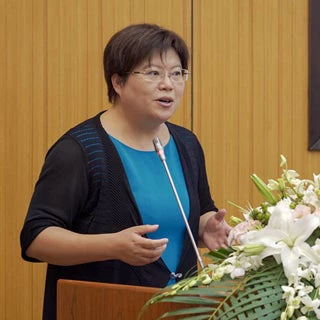Digital government initiatives at the national and sub-national levels in China are evolving at a rapid pace. With the first generation of basic digitization of government operations now complete, Chinese authorities are looking at how leading-edge technologies and big data can further improve the performance of government, both in terms of data-driven decision making and public services.
Recently government officials, academics, and World Bank colleagues gathered at Fudan University in Shanghai for a 2-day Government Performance Management Series Symposium on E-government and Governance Innovation, organized by the Public Performance and Information Research Center of Fudan University. Founded in 1905, Fudan University has a long-standing reputation of providing innovative contributions combining the social and engineering sciences.
The conference provided many rich examples of ongoing initiatives and current practices. The participants highlighted the diversity in public sector innovation and technology application across different agencies and sub-national governments.
Several specific examples illustrate the current frontiers, but also suggest a number of principles and practices for spreading and deepening effective digital government across China:
Refining Performance Management for Over 800,000 Employees of the Tax Authority: The Chinese tax authorities have been at the forefront of deploying institutional innovations and technology to improve service delivery for tax payers and enhance effective revenue mobilization. The leaders have understood that effective human resources management is critical to this effort so they have applied the performance management to all employees to build a merit-based performance evaluation system and peer-learning culture.
Shanghai’s “All in One Net” for Public Service Delivery: Shanghai authorities have established a one-stop that merges public services of all government departments, provides a single portal for individuals and companies, and significantly streamlines application and approval procedures. At the institutional level, Shanghai has established Big Data agencies, which are responsible for pushing requisite data integration on the “back end” to ensure that these platforms can reach their full potential and that information is used effectively.
Promoting Public Sector Innovations in Guangxi: The Guangxi authorities, representing a relatively poor province in Southwest China bordering Vietnam, uses big-data-driven performance management to promote public sector innovation, such as developing technology platforms for poverty targeting and investment tracking. The authorities gained national interest from this initiative, and have also been supported by a World Bank-financed program for results project that integrates the application of big data and technology platforms.
Benchmarking: Benchmarking encourages competition and peer learning across regions. Technology diffusion could yield great efficient gains, especially given China’s diverse provinces, counties and townships. Discussion highlighted a number of on-going paradigm shifts inspired by leading subnational governments. The State Information Center looked at a number of benchmarking indicators for smart cities and studied where contract process is being made. They found changes taking place toward greater and more equally distributed digital government dividends at the national and across sub-national levels. Today China houses half of world’s smart cities. In the same spirit to promote the diffusion of smart agriculture, China Ministry of Agriculture is now scoring all counties in terms of their support to digital agriculture.
How Government Can Reap Digital Dividends?
In government, technology adoption for its own sake has little value unless it can yield tangible results in terms of better service delivery, decision-making, and citizen engagement. This means ensuring that people and processes align and take advantage of the growing opportunities provided by new technologies, especially across different institutional contexts and challenges. To increase public sector performance and reap digital dividends, a few principles and practices should be in place, including:
Data Integration. While “big data” and its benefits have gained strong backing by the national leadership, the realities of making effective data integration happen across siloed departments and systems presents a challenge. Increasingly “big data” departments have been established at all levels, but it is unclear how effective they will be in providing the incentives for better data integration and application. The conference in Fudan underscored that more work needs to be done to ensure institutional change comes from a “people, process, and platform” management perspective.
From Top-Down to Bottom-Up. Many of the first-generation ICT systems initiatives were driven by top-down mandates from higher levels of government to digitize, for example, financial transactions and reporting. However, for China’s digital government to reap digital dividends, it will have to increasingly ensure local stakeholders not just collect data for their own sake, but can use available information and respond to beneficiary feedback of all types.
Data Integrity and Ownership. Big data brings significant opportunities, but also significant risks. Data can be tampered with or subject to cyber breaches. The conference explored how evolving technologies such as distributed ledgers (popularly known as blockchains) can begin to address some of these issues. But the conference made clear that modern digital government data governance will be a critical topic for the next phase of institutional development in China, and for this, sharing global experiences and perspectives will be vital.
Digital Governance. Good data governance needs to strike a balance across public/state, commercial, and privacy interests. Since sub-national governments were both key users and generators of digital data, the practical implications of prevailing and prospective data governance arrangements needs to be more broadly understood and evaluated. Examples such as Singapore’s recent model AI governance framework provided some comparative example of entry points that merit further exploration, in this case for dialogue across the pertinent international and Chinese experiences.
The conference participants agreed that it would be vital to better document experiences from China’s case studies of digital government. These are not always readily accessible, or the institutional context appreciated, by international stakeholders.
As China embarks on its 14th Five-Year Development Plan in 2021, the ability to distill the lessons from the last plan and lay the foundations for productive international exchanges in technology and innovations for better government will be of interest of stakeholders across China and the world.
Editor's Note: This blog was first published on East Asia & Pacific on the Rise.





Join the Conversation